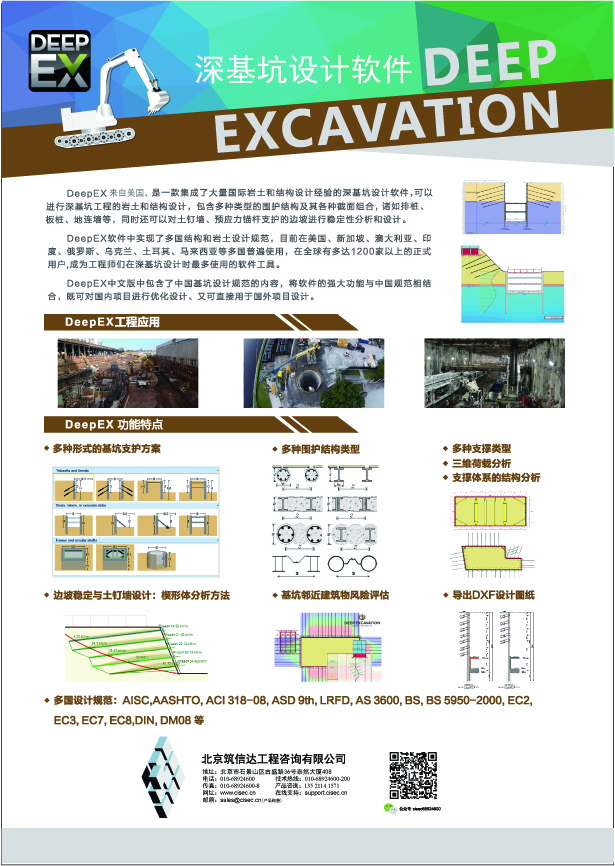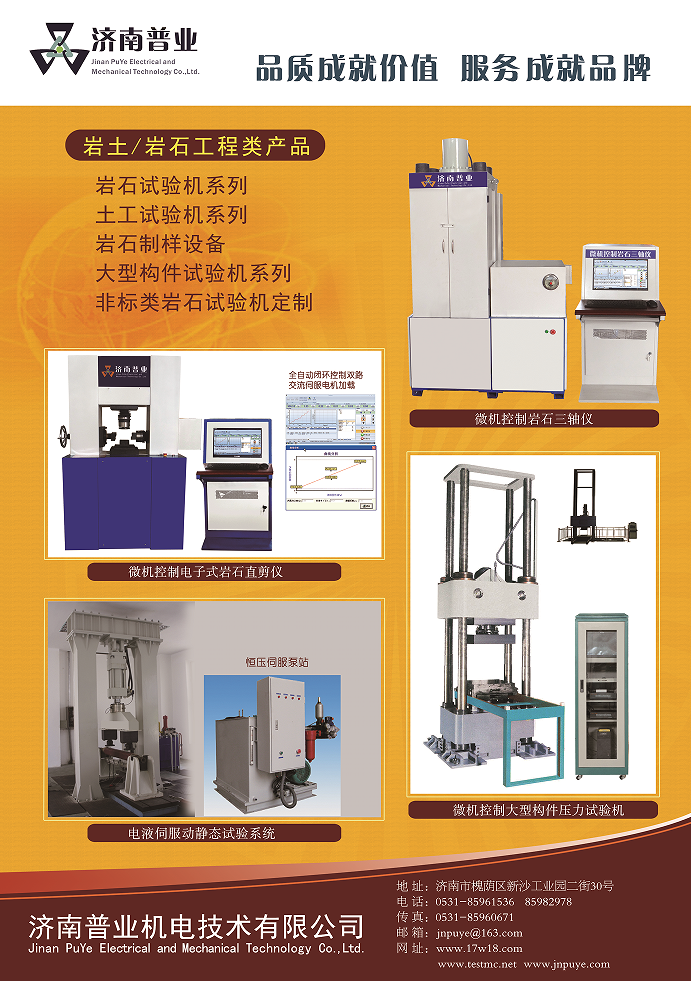Formulae for overall stability of composite soil nailing walls
-
摘要: 预应力锚杆以抗拔力、截水帷幕及微型桩以抗剪强度共同提高了复合土钉墙的整体稳定性。 叠加这些复合构件的抗力作用并对组合效果进行折减,是复合土钉墙整体稳定性验算目前最成熟有效的方法。 验算公式的关键是土、土钉及各复合构件分项抗力系数( 抗力系数即构件抗力产生的抗滑力矩与土体下滑力矩之比 )的 折减系数 。折减系数是经验数值, 可按一定的假设条件从实际工程数据反算整理得出 。对 多个接近临界稳定状态基坑的分析研究及数百个基坑的验证结果表明: 这些复合构件单独及共同与土钉墙作用时,折减系数存在着合理范围 ,分别为预应力锚杆 0.5 ~ 0.7 、截水帷幕 0.3 ~ 0.5 及微型桩 0.1 ~ 0.3 。 此外,土体和土钉的分项抗力系数之和( 不计其它构件作用 )存在着合理下限,大致为 0.86 ~ 0.97 ,如果在满足整体稳定性安全系数的同时满足此条件,复合土钉墙基坑位移一般不大。Abstract: The prestressed anchors by pull-out resistance, cut-off curtains and mini-piles by shear strength together improve the overall stability of composite soil nailing walls. At present, it is the most mature and effective method for calculating the overall stability, which accumulates and reduces the resistance of these composite components. The key to the formulae is the reduction coefficient of breakdown resistance coefficient produced by the soil resistance, soil nails and composite components (the resistance coefficient is the ratio of the resisting torque produced by the components to the downturn torque produced by soil). They are empirical data and can be obtained from actual engineering data by inverse calculation arrangement according to certain assumptions. The studies on some critical excavations and the verified results show that there are reasonable ranges of combination coefficients when these components work individually and jointly, that is, they are 0.5~0.7 for prestressed anchors, 0.3~0.5 for cut off curtains and 0.1~0.3 for mini-piles. In addition, the sum of the breakdown resistance coefficients of soil and soil nails has the reasonable lower limit and it is about 0.86~0.97 (regardless of the other components function). When this condition is satisfied and the overall stability safety coefficient requirement is met, the movement of the excavations is generally small.
-
Keywords:
- composite soil nailing wall /
- overall stab ility /
- formula /
- prestressed anchor /
- cut-off curtain /
- mini-pile
-
[1] 付文光 , 杨志银 . 土钉墙技术的新进展及前景展望 [J]. 岩土工程学报 , 2010, 32 (1): 17 – 21. (FU Wen-guang, YANG Zhi-yin. New progress and development foreground in soil nail walls technology[J]. Chinese Journal of Geotechnical Engineering, 2010, 32 (1): 17 – 21. (in Chinese)) [2] 上海市城市建设和交通委员会 . DG/TJ08 — 61 — 2010 基坑工程技术规范 [S]. 上海 , 2010. (Shanghai Urban Construction and Transportation Committee. DG/TJ08 — 61 — 2010 Technical code for excavation engineering[S]. Shanghai, 2010. (in Chinese)) [3] 深圳市住房和建设局 . SJG05 — 2011 基坑支护技术规范 [S]. 北京 : 工业建筑出版社 , 2011. (Shenzhen Housing and Urban Construction Bureau. SJG05 — 2011 Technical code for retaining protection of excavations in Shenzhen city[S]. Beijing: China Architecture & Building Press, 2011. (in Chinese)) [4] 杨志银 , 张 俊 , 王凯旭 . 复合土钉墙技术的研究及应用 [J]. 岩土工程学报 , 2005, 27 (2): 153 – 156. (YANG Zhi-yin, ZHANG Jun, WANG Kai-xu. Development of composite soil nailing walls[J]. Chinese Journal of Geotechnical Engineering, 2005, 27 (2): 153 – 156. (in Chinese)) [5] 付文光 , 卓志飞 . 对 “ 土钉墙 ” 等术语命名的探讨 [J]. 岩土工程学报 , 2010, 32 (1): 46 – 51. (FU Wen-guang, ZHUO Zhi-fei. Discussion on term definition of soil nail walls[J]. Chinese Journal of Geotechnical Engineering, 2010, 32 (1): 46 – 51. (in Chinese)) [6] 刘国彬 , 王卫东 . 基坑工程手册 [M]. 第 2 版 . 北京 : 中国建筑工业出版社 , 2009. (LIU Guo-bin, WANG Wei-dong. Excavation engineering handbook[M]. 2nd ed. Beijing: China Architecture & Building Press, 2009. (in Chinese)) [7] CARLOS A Lazarte, VICTOR Elias, DAVID Espinoza. Geotechnical engineering circular No. 7-soil nail walls[R]. Washington D C: FHWA, 2003. [8] 李亮辉 , 曹笑颦 . 复合土钉墙在复杂地层条件下的应用 [J]. 岩土工程学报 , 2008, 30 (1): 608 – 611. (LI Liang-hui, CAO Xiao-pin. Application of composite soil nailing walls under condition of complex strata[J]. Chinese Journal of Geotechnical Engineering, 2008, 30 (1): 608 – 611. (in Chinese))








 下载:
下载:
